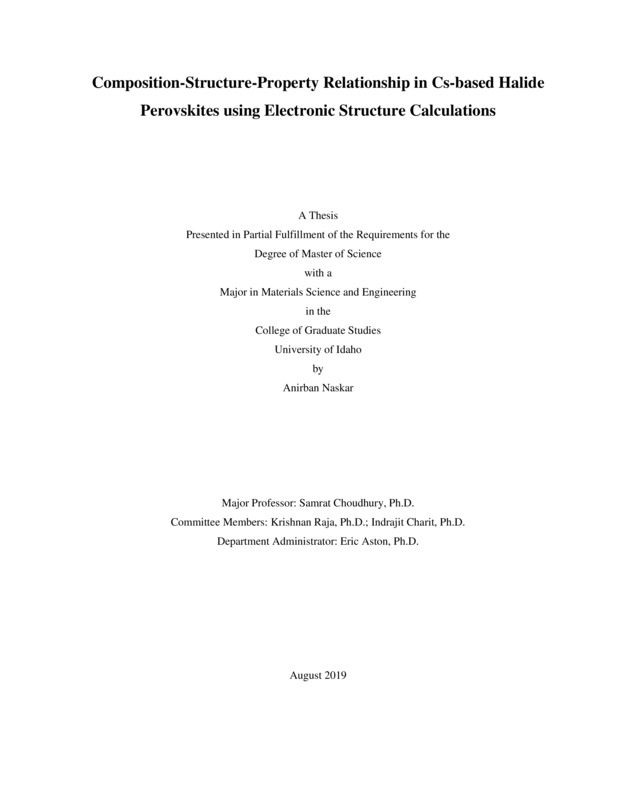Composition-structure-property Relationship in Cs-based halide Perovskites using Electronic Structure Calculations
Naskar, Anirban. (2019-07). Composition-structure-property Relationship in Cs-based halide Perovskites using Electronic Structure Calculations. Theses and Dissertations Collection, University of Idaho Library Digital Collections. https://www.lib.uidaho.edu/digital/etd/items/naskar_idaho_0089n_11673.html
- Title:
- Composition-structure-property Relationship in Cs-based halide Perovskites using Electronic Structure Calculations
- Author:
- Naskar, Anirban
- Date:
- 2019-07
- Embargo Remove Date:
- 2022-09-03
- Program:
- Chemical and Materials Science Engineering
- Subject Category:
- Materials Science
- Abstract:
-
The last three decades have witnessed significant progress in electronic materials due to the constant discovery of new materials for various applications. ABX3 (A = Cs; B = Ca, Sr, Ba; X =I, Br, Cl, or F) s-block halide perovskites are widely considered as a scintillator material and a replacement of lead-based solar device due to their excellent electronic properties. The performance of the device is linked to the atomic and electronic structure of the halide perovskites. Using ab-initio calculations, we studied the effect of chemical composition, atomic structure on the electronic properties (bandgap) of s-block halide perovskite for both bulk and surfaces. We found that the bulk and the surface bandgaps of the perovskites are closely related to the intrinsic properties such as atomic or ionic size, electronegativity, bond-dissociation energy of B and X. The bandgap changes on the surfaces compare to the bulk are explained in terms of the structural changes such as bond-distance and bond-angle. Defects are produced inevitably during the synthesis of these compounds and largely depends on the synthesis condition. It has been reported that the point defects such as antisite defects are detrimental to carrier transport as they create localized electronic (deep trap) defects on the band gap. Using ab-initio calculations, we also investigated the impact of antisite defect, XB on the electronic properties of ABX3 (A = Cs; B = Ca, Sr, or Ba; X =I, Br, Cl, or F) bulk perovskites. Our results reveal that the formation of defect state in the band gap due to antisite defect, XB strongly depends on the composition and the crystal structure. We observed that for a fixed composition of A and B the electronic defect forms at a higher energy level on the bandgap for bigger halogen atom compared to the halogen atom of smaller size. Further, the antisite defect creates localized states at two different locations in the band-gap for the orthorhombic structure. Whereas, for the same composition with the cubic crystal structure, the antisite defect creates a localized electronic state only at one location. Finally, we linked the location of these electronic defect states in the band gap to the intrinsic property of the constituent elements such as bond-dissociation energy and the atomic size, which can be a useful tool to understand and predict the position of localized electronic states produced by the point defects.
- Description:
- masters, M.S., Chemical and Materials Science Engineering -- University of Idaho - College of Graduate Studies, 2019-07
- Major Professor:
- Choudhury, Samrat
- Committee:
- Raja, Krishnan; Charit, Indrajit
- Defense Date:
- 2019-07
- Identifier:
- Naskar_idaho_0089N_11673
- Type:
- Text
- Format Original:
- Format:
- application/pdf
- Rights:
- In Copyright - Educational Use Permitted. For more information, please contact University of Idaho Library Special Collections and Archives Department at libspec@uidaho.edu.
- Standardized Rights:
- http://rightsstatements.org/vocab/InC-EDU/1.0/

